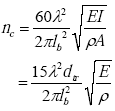Related Resources: mechanics machines
Ball Screw Design Equations and Selection Criteria
Machine Design Resources
Gear Design and Engineering
A ball screw transforms rotational motion into transitional motion. As a result, the shaft is subject to loads:
Ball Screw Design Equations and Selection Criteria:
- Applied load
- Required Torque
- Maximum Rotational Speed
- Resonance (bending) of threaded shaft
- DN force ball screw
- Ball screw life, basic dynamic rating
- Stiffness
- Accuracy
Driving Torque to Obtain Thrust
![]()
Where:
T = Driving torque (Nm)
Fa = Axial thrust force on ball screw (N)
l = Screw lead (m)
η = Efficiency
Thrust Required
Thrust is equal to the sum of all forces acting in the axial direction
Fa = FM + Ff + Fi + Fg
FM = Machining force (N)
Ff = Frictional force (N)
Fi = Inertial force (N)
Fg = Gravitational force (N)
Stresses from Applied Loads


Where:
Fa = Applied axial force (N)
rtr = root radius = root diameter / 2 (m)
T = Applied Torque (N-m)
π = 3.14159
Equivalent (Von Mises) Stress
![]()

Compressive Load

P1 = Buckling load [N]
lb = Distance between mounting positions [m]
E = Elastic modulus [Pa]
I = Second moment of inertia [m4]
λ = Support factor
Fixed – free: λ = 0.25
Fixed – supported: λ = 2.0
Fixed – fixed: λ = 4.0, Fixed -supported = 2.0, Fixed-free = 0.25
Fixed - Free Configuration

Simple - Simple Configuration

Fixed - Simple Configuration

Fixed - Fixed Configuration

Basic Static Loading
- When ball screws are subjected to excessive loads in static condition (non rotating shaft), local permanent deformations are caused between the track surface and the steel balls.
- When the amount of this permanent deformation exceeds a certain degree, smooth movement will be impaired.
![]()
Where:
Coa = Basic static load rating [N, kgf, lbf]
Fs = Static safety factor
Fa = Load on shaft in axial direction [N, kgf, lbf]
| Use | Fs (Lower Limit) |
|---|---|
| Normal | 1.0 - 2.0 |
| With Impacts and Vibrations |
3.2 - 3.0 |
Permissible Ball Screw Speed
When the speed of a ball screw increases, the ball screw will approach its natural frequency, causing a resonance and the operation will become impossible.

Where:
nc = Critical speed [min-1]
lb = Distance between supports [m]
E: Elastic modulus [Pa]
I = Second moment of inertia [m4]
ρ = Density [kg/m3]
A = Root cross sectional area [m2]
λ = Support factor
Fixed – free: λ = 1.875
Supported – supported: λ = 3.142
Fixed – supported: λ = 3.927
Fixed – fixed: λ = 4.730
Spindle Speed and DN Drive
n = Va / l
Where:
n = Revolutions per second ( s-1 )
Va = Axial Speed (m/s)
l = Lead (m)
DN unless otherwise specified
DN ≤ 70000
D = Ball circle diameter (mm)
N = Revolutions per minute (min-1)
Dynamic Load Rating Ca and Life
The basic load rating Ca is the load in the shaft direction with 90% of a group of the same ball screws operating individually will reach a life of 106 (1 million) revolutions.

Where:
L = Rotation life [rev]
Ca = Basic dynamic load rating [N, kgf, lbf]
fw = Load factor
Fa = Load in shaft direction [N, kgf, lbf]
| Use | fw |
|---|---|
| Smooth operation no impacts | 1.0 - 1.2 |
| Normal operation | 1.2 - 1.5 |
| Operation with impacts and vibrations | 1.5 - 2.5 |
Running Lengths depending on Usage
Running distance during acceleration:

Running distance during deceleration:

References:
THK Co. Ltd
Nook Industries
University of Utah, Mechanical Engineering ME EN 7960